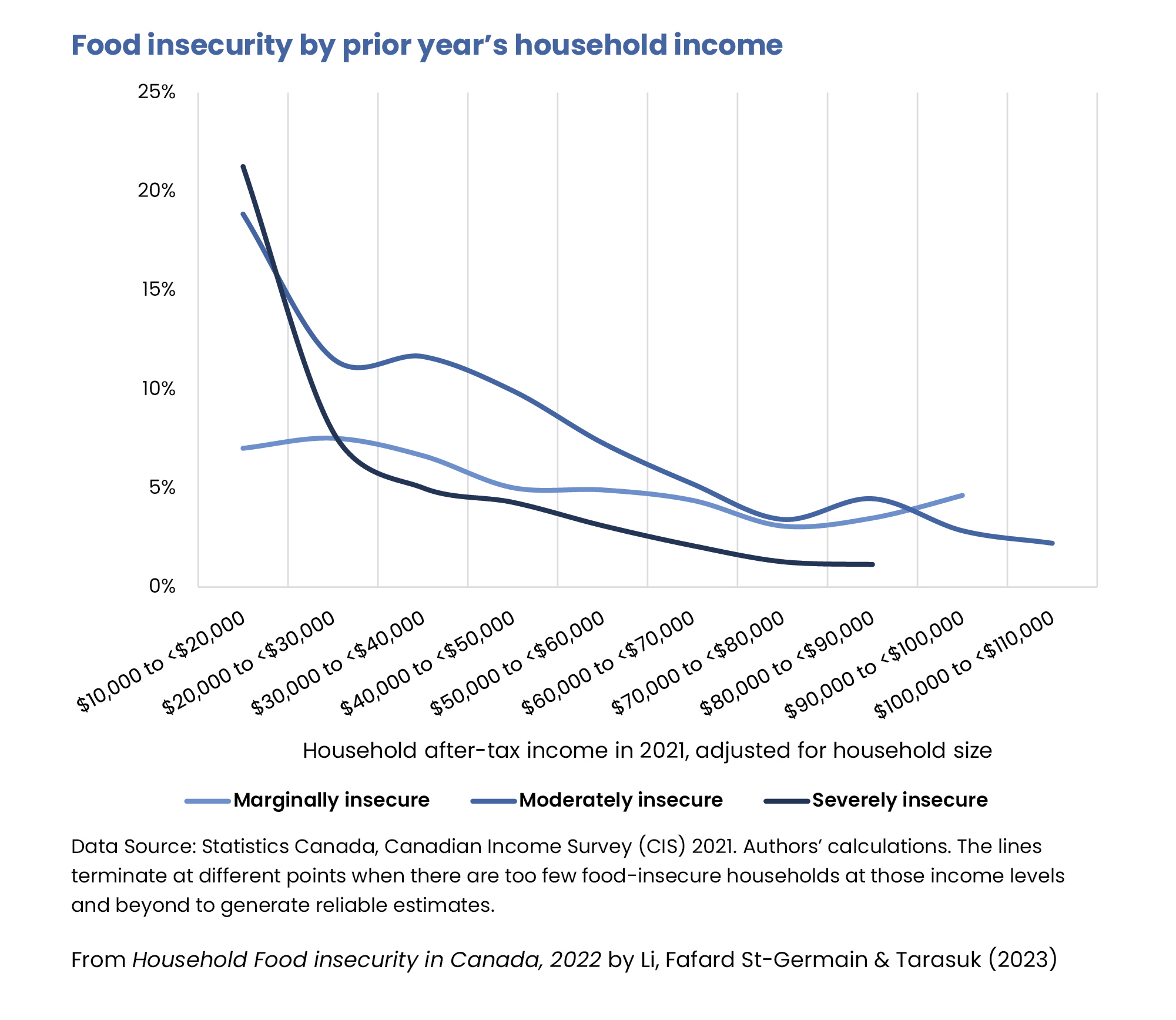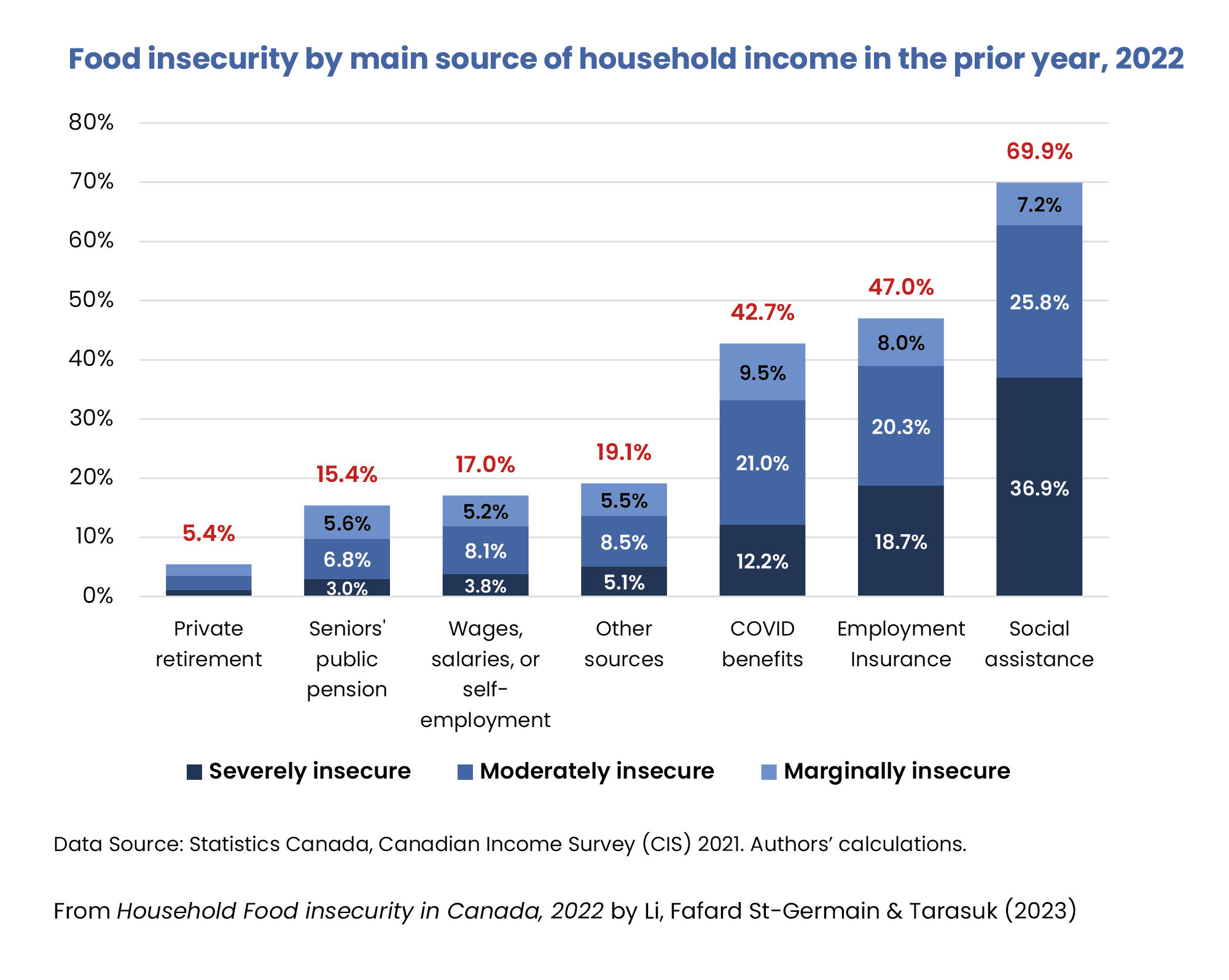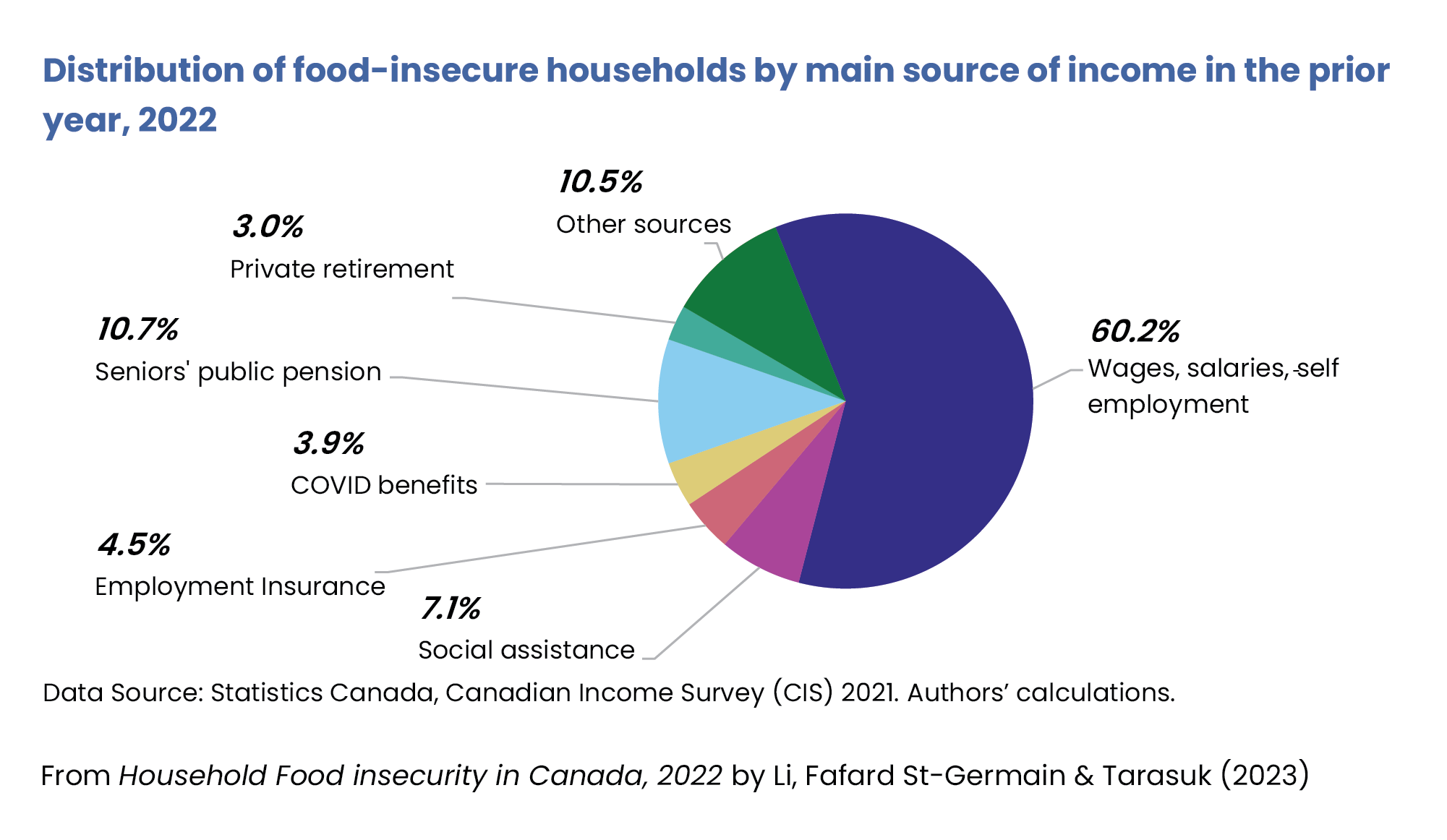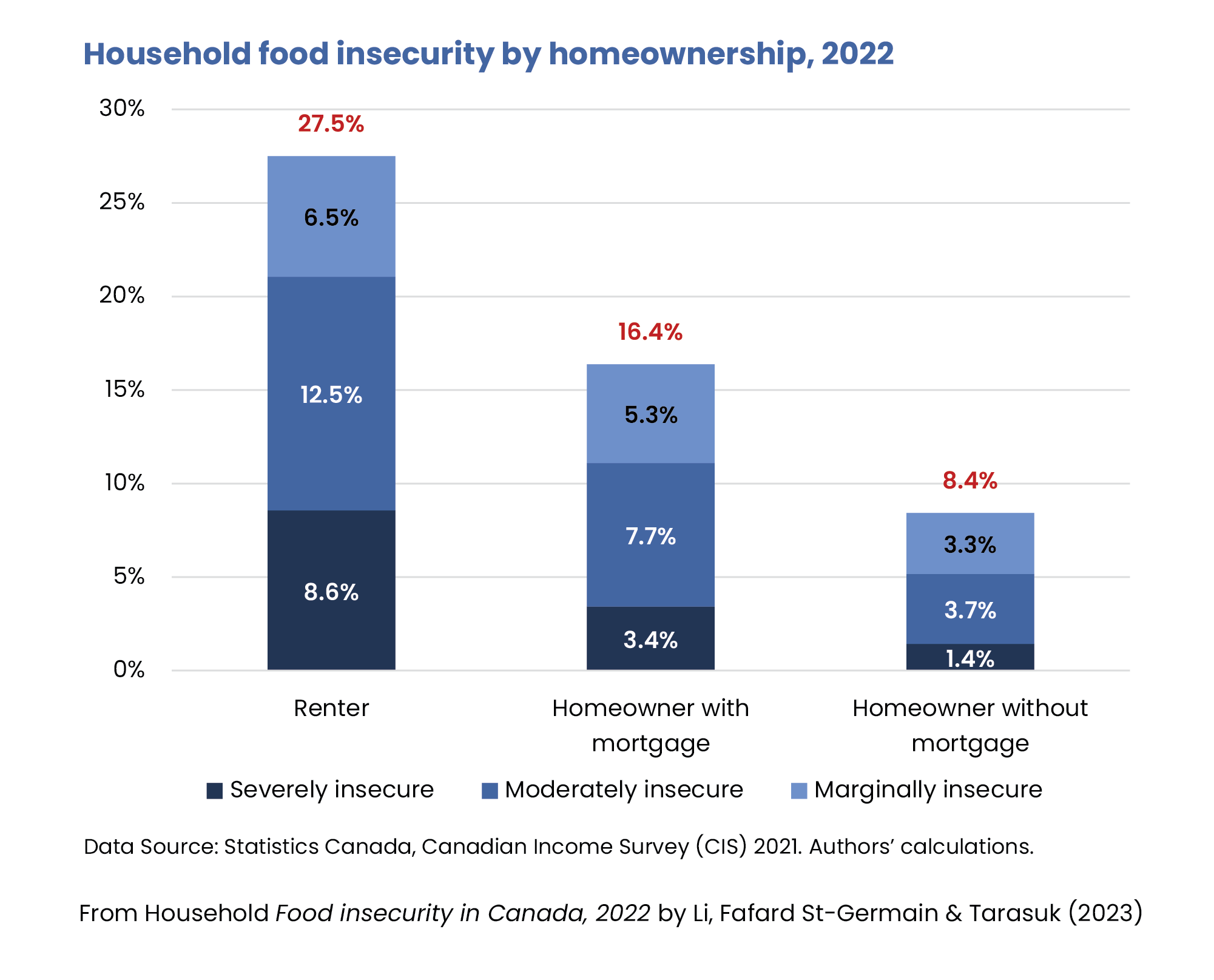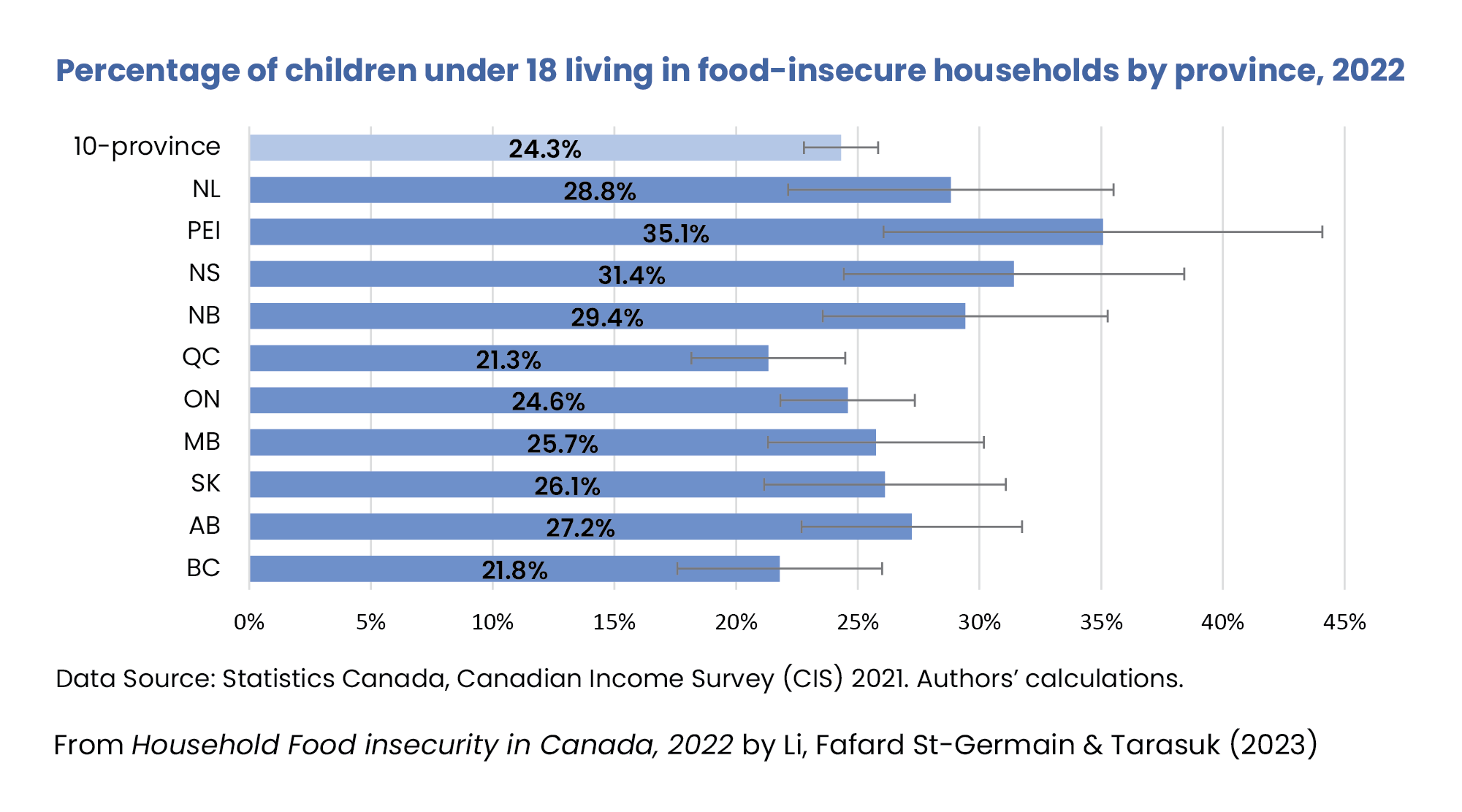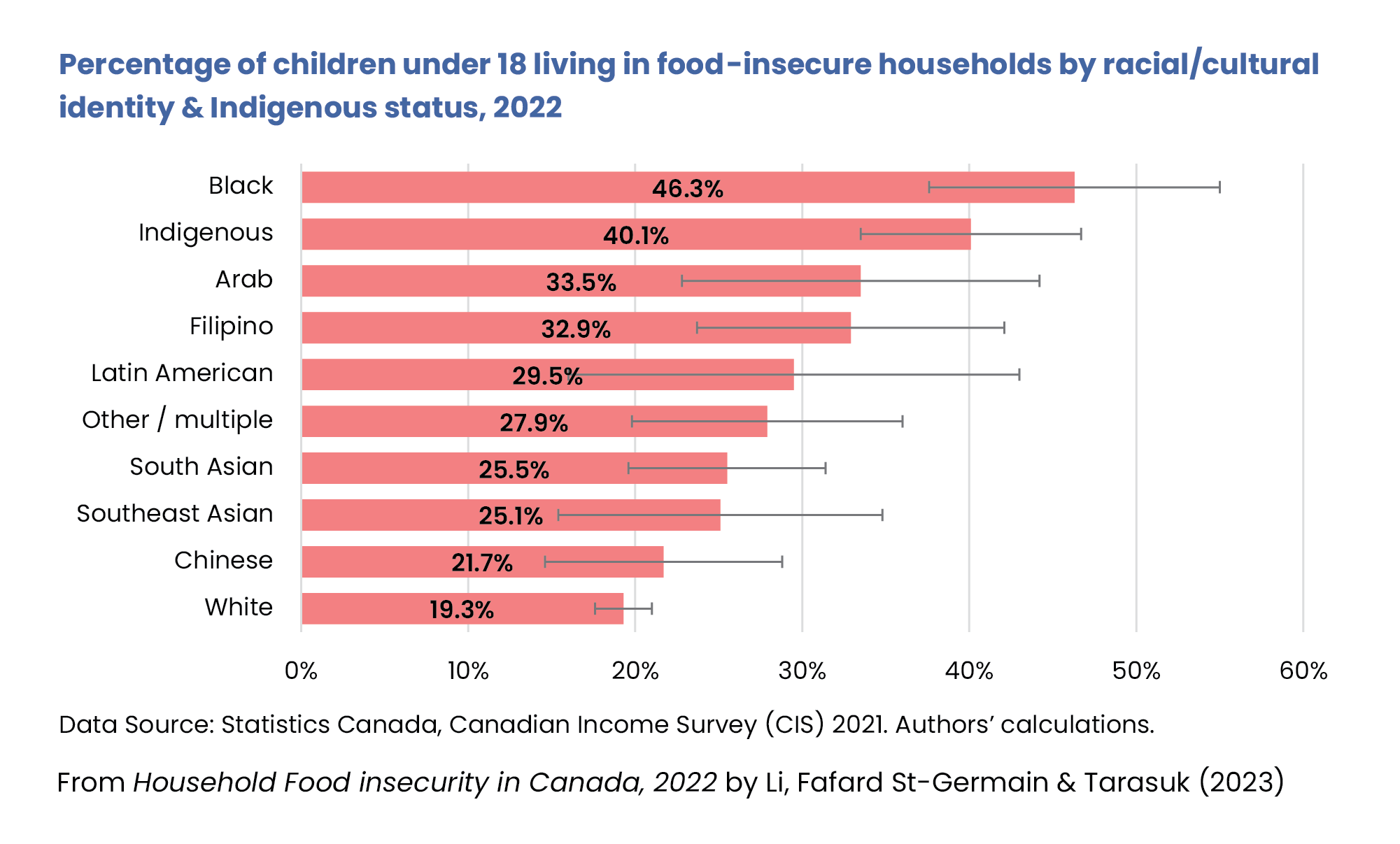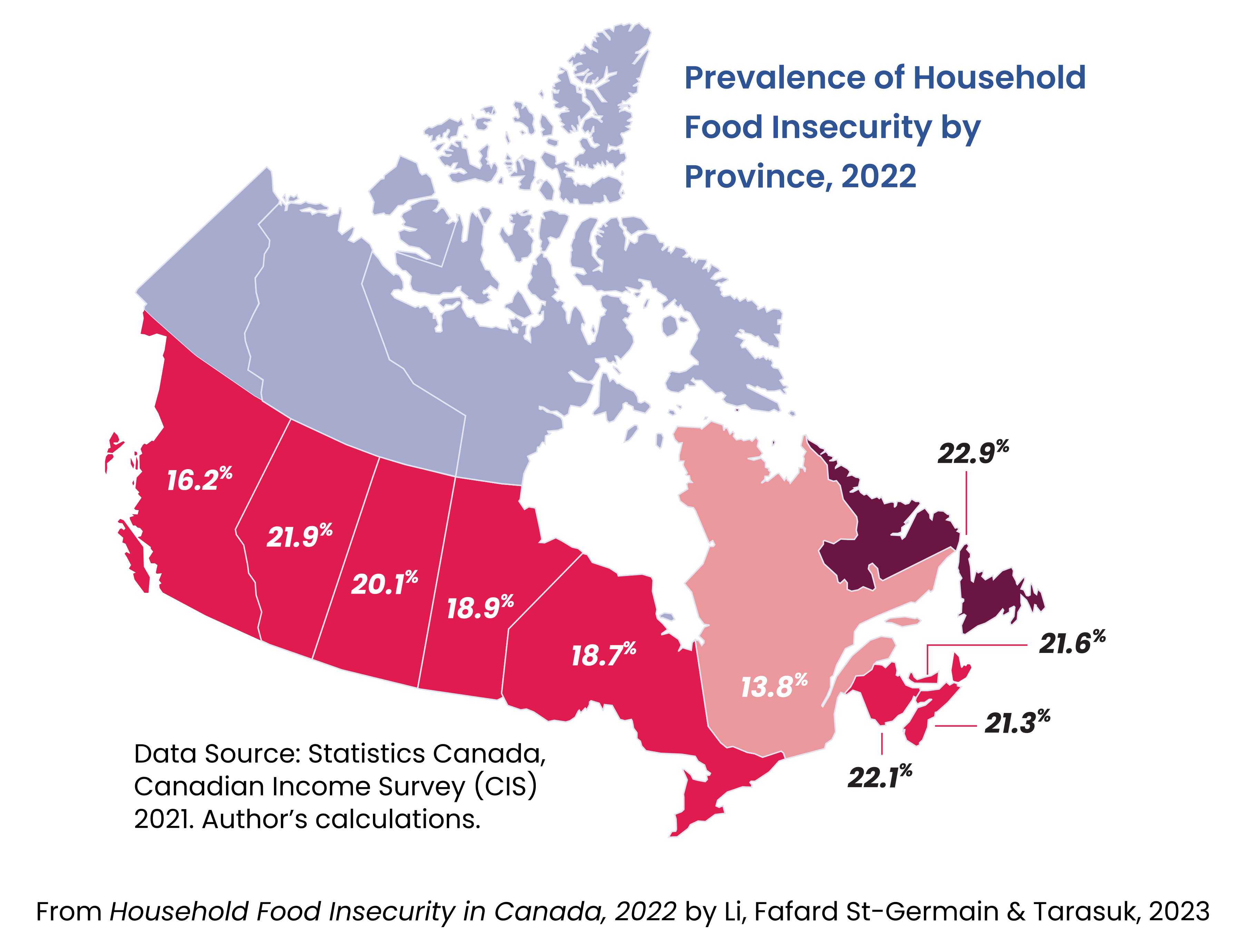Who are most at risk of household food insecurity?
Food insecurity is a measure of material deprivation. It is most prevalent among households with inadequate, insecure incomes and limited, if any, financial assets, or access to credit. This means that population groups who face systemic racism and other forms of discrimination that present barriers to the accumulation of wealth are disproportionately affected by food insecurity. This page summarizes the social and economic conditions that give rise to food insecurity.
Household food insecurity in Canada is tightly linked to income.
As a household’s income declines, the risk of food insecurity increases. Severe food insecurity is particularly sensitive to income. Households with very low incomes are at much higher risk of being severely food-insecure.[1]
The relationship between income and food insecurity is not a perfect one-to-one because food insecurity reflects a household’s broader material circumstances, taking into account the amount and stability of income, assets like property, and other resources a household could draw upon, as well as the cost of living.
There is also some measurement error in our mapping of the relationship between food insecurity and income here because the time period covered by the food insecurity measurement on the Canadian Income Survey does not exactly coincide with the measure of income. See “Interpreting the statistics in this report” in Household Food Insecurity in Canada, 2022 for more information.
Since 2022, Canadians have experienced unprecedented inflation in the prices of food and other necessities. If the incomes of lower income households do not keep up with these rising costs (e.g., through indexation of the wages and benefits upon which these households depend), we can expect the prevalence of severe food insecurity to worsen.
Relying on public income supports, aside from public pensions, means being at greater risk for food insecurity.
Income supports are the fabric of our social safety net and yet the prevalence of food insecurity among households relying on public programs, except seniors’ public pensions, is exceptionally high.[1] This points to the inadequacy of these programs to enable recipients to meet basic needs.
In 2022, 69.9% of households who reported their main source of income as social assistance (provincial welfare and disability programs) in the prior year were food-insecure.[1] The majority of those who manage to qualify for our ‘income support programs of last resort’ are unable to afford food and other necessities. Half of these households are severely food-insecure, meaning they are experiencing the most extreme deprivation and most at risk for poor health outcomes.
The prevalence of food insecurity among households relying on Employment Insurance (EI) or COVID-19 benefits, programs intended to support households facing job disruptions, in the prior year was also very high in 2022.[1]
On the other hand, the prevalence of food insecurity among households relying on seniors’ public pensions is far lower.[1] Research has shown that Canada’s public pension system has a protective effect against food insecurity.[2]
While the prevalence is similar to that among households reliant on employment incomes, households relying on seniors’ public pensions are considerably less likely to be food-insecure once differences in households’ socio-demographic characteristics and economic circumstances are taken into consideration.[1]
Food insecurity remains a serious problem for working Canadians.
Although the prevalence of food insecurity among households relying on employment income is relatively low, they make up most of the food-insecure households in Canada because that’s how most Canadians earn money.
In 2022, 60.2% of food-insecure households reported their main source of income as wages, salaries, or self-employment in the prior year.[1]
Simply having a job is not enough to ensure adequate income for basic needs. The workers most likely to report food insecurity are those with low-wage, short-term or precarious jobs, racialized workers, those working multiple jobs, and those providing for multiple people with a single income.[3]
Renters are more likely to be food-insecure than households that own their homes
Food insecurity is much more prevalent among households who rent rather instead of owning their dwelling. Homeownership typically indicates greater wealth and can serve as a considerable asset to leverage for funds when there is a need, such as dealing with job loss, sudden illness, and other income shocks.
However, not all homeowners are protected equally as the amount of housing debt also matters. The level of protection afforded by homeownership is lower for those with a mortgage than those without since the substantial debt can make them more financially vulnerable.
In 2022, 27.5% of renter households were food-insecure, compared to 16.4% of homeowners with a mortgage and 8.4% of mortgage-free homeowners.[1] Renters also make up half of the households that experience food insecurity.
Recent research also indicates that the protective effect of homeownership is a function of the value of the home (i.e., the size of the housing asset).[4] Owning a home with lower market value could mean diminished leverage for emergency funds and reflect lower income, fewer savings, and potentially more precarious financial circumstances.
Households with children under 18 are more likely to be food-insecure than those without.
In 2022, 1 in 4 children in the ten provinces under the age of 18 lived in a household that experienced some level of food insecurity.[1] This amounted to almost 1.8 million children. Households with children led by female lone parents are especially vulnerable to food insecurity; 41.2% of these households were food-insecure.
In Canada, we have income support programs for households with children (i.e. child benefits) at both the federal and provincial/territorial levels. The increased vulnerability of households to food insecurity raises serious questions about how these programs are designed and whether they are adequate for protecting low-income families from food insecurity.
The racial disparities in food insecurity point to the serious health consequences of Canada’s long and ongoing history of colonialism and systemic racism.
The prevalence of household food insecurity differs markedly by Indigenous status and racial/cultural group. People identifying as white have a lower prevalence of food insecurity than any other group. In 2022, the highest percentage of individuals living in food-insecure households was found among Black people at 39.2%, followed by Indigenous Peoples at 33.4%.[1]
The racial disparities also appear in the percentage of children living in food-insecure households. In 2022, 46.3% of Black children and 40.1% of Indigenous children livied in a food-insecure household.[1]
The situation for Indigenous communities is likely even worse given the lack of representation of people living on First Nations reserves and some remote Northern communities in the national surveys used to monitor food insecurity in Canada.
Other surveys have provided a deeper understanding of the scale and severity of household food insecurity among Indigenous communities and explored other facets of this problem. For an overview of these studies, please see Indigenous Food Insecurity.
The Canadian Income Survey only began collecting race-based data in 2021. It will be important to continue examining this relationship through future cycles of the CIS.
The risk of food insecurity depends on where you live in Canada.
The prevalence of food insecurity varies considerably across the provinces and territories.
These differences may reflect the differences in macroeconomic conditions and policy landscapes. Research has highlighted the important roles that provincial and territorial governments play in protecting their populations from food insecurity, through policies like minimum wage, welfare, and taxation.
Living in Quebec has repeatedly surfaced as being associated with lower odds of being food-insecure than living in Ontario, after accounting for households’ socio-demographic and economic characteristics,[3][5] including in our latest look at data on food insecurity across the provinces in 2022.[1] On the other hand, living in Newfoundland and Labrador, Prince Edward Island, Nova Scotia, New Brunswick, or Alberta were associated with higher odds of being food-insecure in 2022.[1]
The finding that living in Quebec provides some protection against household food insecurity may reflect the province’s more progressive policies and stronger social safety net and warrants further study.
Living in Nunavut means being at far greater risk of being food-insecure and more severely so.[5] In 2022, 46.1% of people in Nunavut, 22.2% of people in Northwest Territories, and 12.8% of people in Yukon lived in food-insecure households in 2022. [2]
Due to unique challenges for data collection and small sample sizes in the North, caution needs to be taken when interpreting these prevalence estimates or comparing them with other statistics. The territorial estimates also cannot be compared to the provincial estimates elsewhere on this page and in our reports because they describe the percentage of people affected, not households.
So what can be done to reduce food insecurity in Canada?
The patterns of vulnerability to food insecurity reflect major social and economic inequities in Canada and the shortcomings of the public income supports making up our social safety net. There is strong evidence showing this problem can be addressed through policy interventions that improve the incomes of low-income households.
Having accurate information on who is most at risk of food insecurity is critical for policy makers, public health planners, and advocacy groups to set priorities and take action.
That’s why PROOF has published status reports to make food insecurity statistics more accessible. See our latest report, Household Food Insecurity in Canada, 2022, for more statistics and information on household food insecurity in Canada.
References
- Li T, Fafard St-Germain AA, Tarasuk V. Household Food Insecurity in Canada, 2022. Toronto: Research to identify policy options to reduce food insecurity (PROOF); 2022. https://proof.utoronto.ca/resource/household-food-insecurity-in-canada-2022/
- McIntyre L, Dutton D, Kwok C, et al. Reduction of food insecurity in low-income Canadian seniors as a likely impact of a Guaranteed Annual Income. Canadian Public Policy. 2016;42(3):274-86. https://doi.org/10.3138/cpp.2015-069
- McIntyre L, Bartoo AC, Emery JC. When working is not enough: food insecurity in the Canadian labour force. Public Health Nutr. 2014;17(1):49-57. https://doi.org/10.1017/S1368980012004053
- Fafard St-Germain AA, Tarasuk V. Homeownership status and risk of food insecurity: examining the role of housing debt, housing expenditure and housing asset using a cross-sectional population-based survey of Canadian households. International Journal for Equity in Health. 2020;19(5):1-12. https://doi.org/10.1186/s12939-019-1114-z
- Tarasuk V, Fafard St-Germain A-A, Mitchell A. Geographic and socio-demographic predictors of household food insecurity in Canada, 2011–12. BMC Public Health. 2019;19(1):12. https://doi.org/10.1186/s12889-018-6344-2
- Statistics Canada. Canadian Income Survey: Territorial estimates, 2021. Statistics Canada; 2022. https://www150.statcan.gc.ca/n1/daily-quotidien/230621/dq230621c-eng.htm
